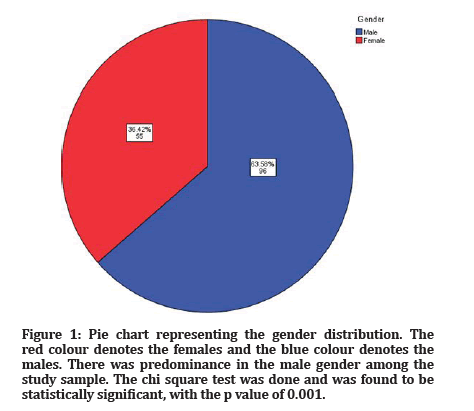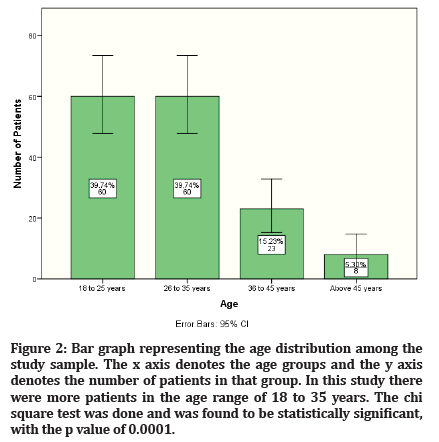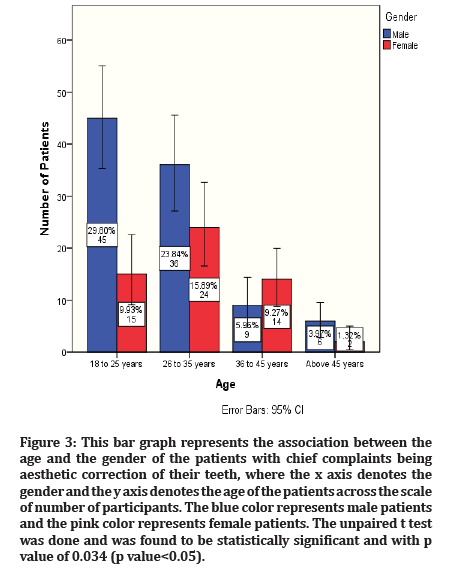Research - (2022) Volume 10, Issue 8
Prevalence of Age and Gender of Patients Reporting for Aesthetic Restoration-University Based
Swetha Ilangovan and Mahalakshmi J*
*Correspondence: Mahalakshmi J, Department of Conservative Dentistry and Endodontics, Saveetha Dental College and Hospitals, Saveetha Institute of Medical and Technical Sciences, Saveetha University, India, Email:
Abstract
Introduction: Aesthetic dentistry is dental treatments which tend to make one’s face or teeth more beautiful and pleasing to the eyes in appearance. It can be as simple as replacing discolored or cracked restorations with a natural looking one. It focuses on improving the overall smile appearance and the confidence of a person. Materials and Methods: The data was collected from Digital Information Archiving Software (DIAS) of Saveetha Dental College. The data was collected from November 2020 to January 2021. The data included patients who had undergone aesthetic restoration. The data was tabulated and entered in excel and the data was analysed using SPSS package software. p<0.05 was considered to be the level of statistical significance in the study. Results: From this study we have found that males of age 18 to 35 are more prone to get aesthetic correction of their teeth, p<0.05. Conclusion: Within the limitations of the study, we have found that patients are more willing and are conscious of their anterior teeth than their posterior teeth and the younger age group is more concerned about their dental aesthetic.
Keywords
Age, Aesthetic dentistry, Gender, Innovative technology, Prevalence
Introduction
Teeth have always been considered a factor of beauty and till this day are indicators of health, age and sometimes even social status. Previously dentistry was focused on only the restorative aspect. With the decreases in the prevalence of caries, it has shifted from functional dentistry to aesthetic dentistry. Many patients will find the anterior six teeth indispensable, while having grossly decayed or sometimes even missing posterior teeth [1,2].
The union of the "art and science of dentistry" is referred to as aesthetic dentistry. A practitioner can accomplish great aesthetic and functional results by using both technical and artistic talents at the same time. The importance of diagnostic and treatment planning before any procedure cannot be overstated, since oral health and function are essential for a successful aesthetic outcome in dentistry. In recent days, one of the most influencing methods for dental treatment is social media, especially among the younger generation. The main driving force among the aesthetic treatment is usually the social acceptance rather than oral function improvement [3]. Dental aesthetics is defined by the visual appearance of the teeth - proportions, shade, size, the extent of exposure of the teeth and the gingiva [4,5]. The dental aesthetic has a huge psychosocial impact in this society [6]. A little deviation from the usual community norms can cause severe lack of confidence and self-esteem in individuals [7]. The dental aesthetics lets people express themselves confidently. Perception of the individual of their own teeth and their self-image reflects in their behaviour [8].
An aesthetic smile is the consequence of the interaction of a variety of factors of different importance, and an understanding of the concepts that govern the balance between dental practitioners' knowledge of smile aesthetics and patients' perceptions is critical. Competencies are the skills that a dental graduate must possess in order to begin practicing dentistry [9]. Our team has extensive knowledge and research experience that has translated into high quality publications [10– 29]. This research is needed to determine the need for aesthetic correction within the general public. This would be of valuable information to the oral health planners for proposing strategies for development of dental health care management. The aim of the study is to find the prevalence of age and gender of patients coming for aesthetic correction.
Materials and Methods
Study setting
setting This present study was conducted as a retrospective cross sectional study among the patients visiting Saveetha Dental College, Chennai, Tamil Nadu. The study setting was a hospital setting. The present study was ethically approved by the institutional ethical committee. The patients included in this study had visited the dental clinic and had undergone an aesthetic treatment for their teeth. A total of 75000 patients records were reviewed and analysed. The age group of the patients enrolled in this study was above 18 years and they were grouped as 18 to 25 years, 25 to 35 years and 36 to 45 years and above 45 years of age. Sampling bias was reduced by simple random sampling. The study was done in the time period of November 2020 to January 2021. The study sample included both male and female genders but was predominantly South Indian of varied populations due to the geographic limitations.
Data collection
The data collected from the patients were demographic data (Age, Gender, Address etc.). Then clinical examination was done both intraoral and extraoral. All the patients included in this study had to undergo treatment of aesthetic correction for their teeth. All these records were recorded in DIAS- Dental information Archiving Software of Saveetha Dental College. Any incomplete data was verified from the concerned department or the patient. Any gross data which had the possibility of bias and could affect the studies was not included. The data was photographically registered for dent legal documentation, communication and to improve the learning process . All the data collected was cross verified by another examiner.
Data analysis
Data was entered into a spreadsheet using Excel version 16.37 (Microsoft Corp, Redmond, Wash).The data which was collected was analysed using Statistical Package for Social sciences (SPSS) software, version 1.0.0.1347 64 bit (IBM corp., NY, USA). The data was assessed by being subjected to descriptive analysis with the help of frequencies, percentages, means and the data was also analysed by running descriptive statistics in the form of crosstabs.
The type of analysis done was correlation and association. Univariate analysis was done between individual factors. Nonparametric test - Chi square test of Independence and unpaired t- test was performed using the same SPSS software to find the statistical significance of the current study. p<0.05 was considered to be the level of statistical significance.
Results and Discussion
In this study, we assessed the number of patients visiting for aesthetic restoration. The total number of patients included in this study was 151 patients. All the patients had visited the dental clinic of Saveetha Dental College and Hospital and had chief complaints about the aesthetics of their teeth. The gender distribution among the patients was 36.42% were females and 63.58% were males, p<0.05 (Figure 1 and Table 1). The age distribution was 39.74% in 18 to 25 years, 39.74% in 26 to 35 years, 15.23% in 36 to 45 years and 5.30% above the age of 45 years, p<0.05 (Figure 2 and Table 1). 29.8% were males and 9.93% were females in the 18 to 25 years, 23.84% were males and 15.89% were females in 26 to 35 year group, 5.96% and 9.27% were of 36 to 45 age group and 3.97% were males and 1.32% was females above the age of 45 years (Figure 3).
| Age | Gender | |
|---|---|---|
| Chi-Square | 55.437a | 11.132b |
| df | 3 | 1 |
| Asymp. Sig. | 0 | 0.001 |
Table 1: Chi square test for the age and gender.

Figure 1: Pie chart representing the gender distribution. The red colour denotes the females and the blue colour denotes the males. There was predominance in the male gender among the study sample. The chi square test was done and was found to be statistically significant, with the p value of 0.001.

Figure 2: Bar graph representing the age distribution among the study sample. The x axis denotes the age groups and the y axis denotes the number of patients in that group. In this study there were more patients in the age range of 18 to 35 years. The chi square test was done and was found to be statistically significant, with the p value of 0.0001.

Figure 3: This bar graph represents the association between the age and the gender of the patients with chief complaints being aesthetic correction of their teeth, where the x axis denotes the gender and the y axis denotes the age of the patients across the scale of number of participants. The blue color represents male patients and the pink color represents female patients. The unpaired t test was done and was found to be statistically significant and with p value of 0.034 (p value<0.05).
We see a declining trend for aesthetic correction as the age increases. In our study males underwent more aesthetic correction when compared to females. Vallittu, et al. evaluated the prevalence of gender for aesthetic correction and found that the appearance of teeth were more important to females when compared to males [30].
A study in Turkey had reported that females had more prevalence for aesthetic correction which is opposite to our study [31]. Identification by the patients about unaesthetic characteristics is influenced by the social context and the cultures milieu of objective criteria [32]. There are many factors which contribute to the dental aesthetics like shape of the teeth, colour of the teeth and alignment of the teeth in the dental arch [33,34]. The main concern among the patients is the shade of the teeth. There are certain limitations to the study. There was a geographic limitation which had more of the South Indian population and this was a cross sectional. The sample size and the duration of the study can be expanded for better results. For future scope of the research larger sample size and inclusion of different ethnicity will provide better results. Longitudinal and periodic studies could be done to evaluate the status of patients' satisfaction with their aesthetic correction and if it improved their life. This study helps in giving valuable information to oral health planners for proposing strategies to help in development of dental health care management.
Conclusion
Within the limitations of the study, we found that more male patients were willing for aesthetic restorations. The need for dental aesthetics linearly reduces as the age increases. The young adults are more willing for aesthetic restorations.
Acknowledgement
The authors would like to acknowledge the help and support rendered by the Department of Aesthetic Dentistry and Information Technology department of SIMATS for their constant assistance with the research.
Funding
The present study is sponsored by
Saveetha Institute of Medical and Technical Sciences, Saveetha Dental College and Hospitals, Saveetha University, India
Thomas Cook Private Ltd., Chennai.
Conflict of Interest
Authors declare no potential conflict of interest.
References
- Tervonen T. Condition of prosthetic constructions and subjective needs for replacing missing teeth in a Finnish adult population. J Oral Rehabil 1988; 15:505–513.
- Tervonen T, Knuuttila M. Awareness of dental disorders and discrepancy between “objective” and “subjective” dental treatment needs. Community Dent Oral Epidemiol 1988; 16:345–348.
- Theobald AH, Wong BKJ, Quick AN, et al. The impact of the popular media on cosmetic dentistry. N Z Dent J 2006; 102:58–63.
- McNamara L, McNamara JA, Ackerman MB, et al. Hard-and soft-tissue contributions to the esthetics of the posed smile in growing patients seeking orthodontic treatment. Am J Orthod Dentofacial Orthop 2008; 133:491–499.
- Zawawi KH, Malki GA, Al-Zahrani MS, et al. Effect of lip position and gingival display on smile and esthetics as perceived by college students with different educational backgrounds. Clin Cosmet Investig Dent 2013; 5:77–80.
- Nazir R, Mahmood A, Anwar A. Assessment of psychosocial impact of dental aesthetics and self-perceived orthodontic treatment need in young adults. Pakistan Oral Dent J 2014; 34.
- Feu D, de Oliveira BH, de Oliveira Almeida MA, et al. Oral health-related quality of life and orthodontic treatment seeking. Am J Orthod Dentofacial Orthop 2010; 138:152–159.
- Afroz S, Rathi S, Rajput G, et al. Dental esthetics and its impact on psycho-social well-being and dental self-confidence: A campus based survey of north Indian university students. J Indian Prosthodont Soc 2013; 13:455–460.
- Kalkwarf KL, Haden NK, Valachovic RW. ADEA commission on change and innovation in dental education. J Dent Educ 2005; 69:1085–1087.
- Subramanyam D, Gurunathan D, Gaayathri R, et al. Comparative evaluation of salivary malondialdehyde levels as a marker of lipid peroxidation in early childhood caries. Eur J Dent 2018; 12:67–70.
- Ramadurai N, Gurunathan D, Samuel AV, et al. Effectiveness of 2% articaine as an anesthetic agent in children: Randomized controlled trial. Clin Oral Investig 2019; 23:3543–3550.
- Ramakrishnan M, Dhanalakshmi R, Subramanian EM. Survival rate of different fixed posterior space maintainers used in paediatric dentistry–A systematic review. Saudi Dent J 2019; 31:165-172.
- Jeevanandan G, Thomas E. Volumetric analysis of hand, reciprocating and rotary instrumentation techniques in primary molars using spiral computed tomography: An in vitro comparative study. Eur J Dent 2018; 12:21–26.
- Princeton B, Santhakumar P, Prathap L. Awareness on preventive measures taken by health care professionals attending COVID-19 patients among dental students. Eur J Dent 2020; 14:105–109.
- Saravanakumar K, Park S, Mariadoss AVA, et al. Chemical composition, antioxidant, and anti-diabetic activities of ethyl acetate fraction of Stachys riederi var. japonica (Miq.) in streptozotocin-induced type 2 diabetic mice. Food Chem Toxicol 2021; 155:112374.
- Wei W, Li R, Liu Q, et al. Amelioration of oxidative stress, inflammation and tumor promotion by tin oxide-sodium alginate-polyethylene glycol-allyl isothiocyanate nanocomposites on the 1,2-dimethylhydrazine induced colon carcinogenesis in rats. Arabian J Chem 2021; 14:103238.
- Gothandam K, Ganesan VS, Ayyasamy T, et al. Antioxidant potential of theaflavin ameliorates the activities of key enzymes of glucose metabolism in high fat diet and streptozotocin-induced diabetic rats. Redox Rep 2019; 24:41–50.
- Su P, Veeraraghavan VP, Krishna Mohan S, et al. A ginger derivative, zingerone-a phenolic compound-induces ROS-mediated apoptosis in colon cancer cells (HCT-116). J Biochem Mol Toxicol 2019; 33:e22403.
- Mathew MG, Samuel SR, Soni AJ, et al. Evaluation of adhesion of Streptococcus mutans, plaque accumulation on zirconia and stainless steel crowns, and surrounding gingival inflammation in primary molars: Randomized controlled trial. Clin Oral Investigations 2020; 24:3275–3280.
- Sekar D, Johnson J, Biruntha M, et al. Biological and clinical relevance of micrornas in mitochondrial diseases/dysfunctions. DNA Cell Biol 2020; 39:1379–1384.
- Velusamy R, Sakthinathan G, Vignesh R, et al. Tribological and thermal characterization of electron beam physical vapor deposited single layer thin film for TBC application. Surf Topogr Metrol Prop 2021; 9:025043.
- Aldhuwayhi S, Mallineni SK, Sakhamuri S, et al. Covid-19 knowledge and perceptions among dental specialists: A cross-sectional online questionnaire survey. Risk Manag Healthc Policy 2021; 14:2851–2861.
- Sekar D, Nallaswamy D, Lakshmanan G. Decoding the functional role of long noncoding RNAs (lncRNAs) in hypertension progression. Hypertens Res 2020; 43:724.
- Bai L, Li J, Panagal M, et al. Methylation dependent microRNA 1285-5p and sterol carrier proteins 2 in type 2 diabetes mellitus. Artif Cells Nanomed Biotechnol 2019; 47:3417–3422.
- Sekar D. Circular RNA: A new biomarker for different types of hypertension. Hypertens Res 2019; 42:1824.
- Sekar D, Mani P, Biruntha M, et al. Dissecting the functional role of microRNA 21 in osteosarcoma. Cancer Gene Ther 2019; 26:179–182.
- Duraisamy R, Krishnan CS, Ramasubramanian H, et al. Compatibility of nonoriginal abutments with implants: Evaluation of microgap at the implant-abutment interface, with original and nonoriginal abutments. Implant Dent 2019; 28:289–295.
- Parimelazhagan R, Umapathy D, Sivakamasundari IR, et al. Association between tumor prognosis marker visfatin and proinflammatory cytokines in hypertensive patients. Biomed Res Int 2021; 2021:8568926.
- Syed MH, Gnanakkan A, Pitchiah S. Exploration of acute toxicity, analgesic, anti-inflammatory, and anti-pyretic activities of the black tunicate, Phallusia nigra (Savigny, 1816) using mice model. Environ Sci Pollut Res Int 2021; 28:5809–5821.
- Vallittu PK, Vallittu AS, Lassila VP. Dental aesthetics--a survey of attitudes in different groups of patients. J Dent 1996; 24:335–338.
- Hamamci N, Başaran G, Uysal E. Dental aesthetic index scores and perception of personal dental appearance among Turkish university students. Eur J Orthod 2009; 31:168–173.
- Jenny J. A social perspective on need and demand for orthodontic treatment. Int Dent J 1975; 25:248–256.
- Zagar M, Knezović Zlatarić D. Influence of esthetic dental and facial measurements on the Caucasian patients’ satisfaction. J Esthet Restor Dent 2011; 23:12–20.
- Koralakunte PR, Budihal DH. A clinical study to evaluate the correlation between maxillary central incisor tooth form and face form in an Indian population. J Oral Sci 2012; 54:273–278.
Indexed at, Google Scholar, Cross Ref
Indexed at, Google Scholar, Cross Ref
Indexed at, Google Scholar, Cross Ref
Indexed at, Google Scholar, Cross Ref
Indexed at, Google Scholar, Cross Ref
Indexed at, Google Scholar, Cross Ref
Indexed at, Google Scholar, Cross Ref
Indexed at, Google Scholar, Cross Ref
Indexed at, Google Scholar, Cross Ref
Indexed at, Google Scholar, Cross Ref
Indexed at, Google Scholar, Cross Ref
Indexed at, Google Scholar, Cross Ref
Indexed at, Google Scholar, Cross Ref
Indexed at, Google Scholar, Cross Ref
Indexed at, Google Scholar, Cross Ref
Indexed at, Google Scholar, Cross Ref
Indexed at, Google Scholar, Cross Ref
Indexed at, Google Scholar, Cross Ref
Indexed at, Google Scholar, Cross Ref
Indexed at, Google Scholar, Cross Ref
Indexed at, Google Scholar, Cross Ref
Indexed at, Google Scholar, Cross Ref
Indexed at, Google Scholar, Cross Ref
Indexed at, Google Scholar, Cross Ref
Indexed at, Google Scholar, Cross Ref
Indexed at, Google Scholar, Cross Ref
Indexed at, Google Scholar, Cross Ref
Indexed at, Google Scholar, Cross Ref
Author Info
Swetha Ilangovan and Mahalakshmi J*
Department of Conservative Dentistry and Endodontics, Saveetha Dental College and Hospitals, Saveetha Institute of Medical and Technical Sciences, Saveetha University, IndiaCitation: Swetha Ilangovan, Mahalakshmi J, Prevalence of Age and Gender of Patients Reporting for Aesthetic Restoration-University Based, J Res Med Dent Sci, 2022, 10 (8):01-04
Received: 15-Jul-2022, Manuscript No. JRMDS-22-69301; , Pre QC No. JRMDS-22-69301 (PQ); Editor assigned: 18-Jul-2022, Pre QC No. JRMDS-22-69301 (PQ); Reviewed: 02-Aug-2022, QC No. JRMDS-22-69301; Revised: 05-Aug-2022, Manuscript No. JRMDS-22-69301 (R); Published: 12-Aug-2022
